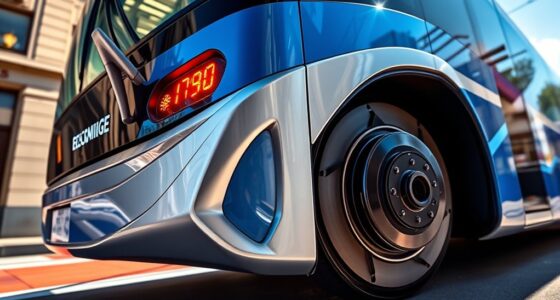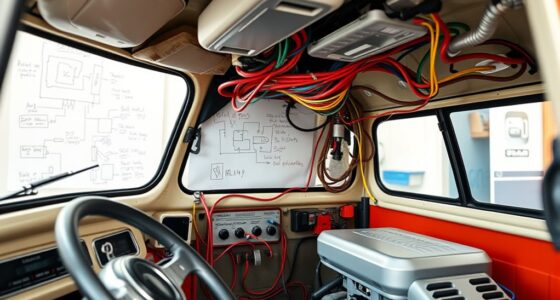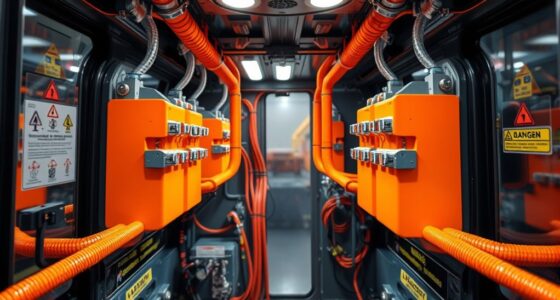The CAN bus is the core technology that allows your VW ID Buzz’s electronic systems to communicate quickly and reliably. Think of it as a digital nervous system that connects sensors, controllers, and safety features without tons of wiring. It guarantees your vehicle responds instantly to your commands and maintains overall safety and efficiency. Curious about how this clever system keeps everything running smoothly? Keep going to uncover more about this essential modern vehicle tech.
Key Takeaways
- The CAN bus is a digital communication system that connects various electronic modules in your VW ID Buzz.
- It enables real-time data sharing, ensuring smooth and safe vehicle operation without complex wiring.
- The “funny name” reflects its role as the vehicle’s digital nervous system, coordinating signals like safety alerts and driver commands.
- CAN bus technology improves reliability, reduces weight, and supports advanced features like electric and autonomous driving.
- It is essential for the seamless interaction of sensors, controllers, and actuators that keep your VW ID Buzz running efficiently.

Have you ever wondered how modern vehicles communicate different systems seamlessly? It’s pretty fascinating how everything from your engine to your infotainment system works together without you noticing. That’s where vehicle networking comes into play, and one of the key technologies behind it is the CAN bus. Short for Controller Area Network bus, this system acts like a digital nervous system, connecting various electronic components in your car. When you turn on your VW ID Buzz, dozens of electronic modules need to share information rapidly and reliably. That’s exactly what the CAN bus handles by enabling efficient data transmission across the vehicle.
Think of it as a busy highway where different vehicles—your car’s sensors, controllers, and actuators—are constantly exchanging messages. The beauty of this setup is that it doesn’t require complex wiring for each individual component. Instead, multiple systems are linked via a single, shared data bus, drastically reducing the complexity and weight of wiring harnesses. This setup allows for quick, real-time data transmission, ensuring your vehicle responds instantly to your commands or changing conditions on the road.
When you press the pedal or activate your turn signal, signals are sent through the CAN bus to relevant modules, which then coordinate the necessary responses. For instance, if your brake system detects an issue, it communicates with the vehicle’s dashboard and safety systems instantly. This rapid data exchange ensures safety, efficiency, and a smoother driving experience. Because the CAN bus is so reliable and fast, it’s become a standard in most modern vehicles, including electric models like the VW ID Buzz.
Understanding vehicle networking and data transmission through the CAN bus also helps you appreciate the complexity and sophistication of your vehicle. It’s not just about turning the key or pressing a button; it’s about a highly coordinated network that keeps your car running efficiently and safely. The system is designed to be robust, capable of handling multiple messages simultaneously without confusion or delay. This resilience is essential, especially in electric or autonomous vehicles, where constant data flow is critical.
In essence, the CAN bus is the silent hero behind your vehicle’s smart features. It ensures that every electronic component, sensor, and control unit works together harmoniously. So next time you get into your VW ID Buzz or any modern vehicle, remember that behind the scenes, a clever network is working tirelessly to keep you connected and safe through seamless data transmission. Moreover, the robustness of the CAN bus system is vital for maintaining vehicle safety and ensuring reliable operation under various conditions.
Frequently Asked Questions
CAN CAN Bus Be Hacked Remotely?
You might wonder if CAN bus can be hacked remotely. While vehicle security has improved, vulnerabilities still exist that could allow remote access by hackers. They could potentially manipulate your car’s systems if they find weaknesses in the network. To stay safe, verify your vehicle’s software is up-to-date and use security features provided by manufacturers. Always be cautious about remote access points, as they’re potential entry routes for cyber threats.
How Does CAN Bus Differ From Ethernet?
Think of CAN bus as a walkie-talkie for your car, enabling vehicle communication through a simple, robust network. Unlike Ethernet, which is like a high-speed internet connection for your home, CAN bus is designed for automotive networking, handling small data packets efficiently. Ethernet supports larger data and faster speeds, making it ideal for multimedia and advanced systems. Both serve different needs in modern vehicle communication.
Is CAN Bus Used in Non-Automotive Applications?
Yes, CAN bus is used in non-automotive applications like industrial communication and home automation. You’ll find it connecting sensors, controllers, and devices efficiently, thanks to its reliable data transfer and robustness. Its simplicity and low cost make it ideal for these environments. So, if you’re working on industrial or smart home projects, CAN bus can help you create seamless, integrated systems without the complexity of other protocols.
What Are Common Signs of CAN Bus Failure?
Did you know that around 45% of vehicle electrical problems are linked to CAN bus issues? If you notice warning indicator lights flickering or your dashboard behaving erratically, it’s a sign of potential CAN bus failure. During diagnostic troubleshooting, you might also experience communication errors or data loss from sensors. Stay alert to these signs, as early detection can save you time and costly repairs later.
CAN I Upgrade My Vehicle’S CAN Bus System?
You can upgrade your vehicle’s CAN bus system, but first, check vehicle compatibility and available upgrade options. Not all systems are easily compatible with aftermarket parts, so it’s essential to research or consult a professional. Upgrading can enhance performance or add features, but guarantee the parts you choose match your vehicle’s specifications. Always verify compatibility to avoid potential issues or system failures.
Conclusion
Now that you understand CAN Bus, think of it as the nervous system of your VW ID Buzz, keeping all its parts in sync like a well-choreographed dance. Without this tech, your vehicle’s brain wouldn’t be able to communicate smoothly. So, next time you hop into your electric wonder, remember that behind the scenes, a tiny but mighty network keeps everything running seamlessly—like a hidden conductor guiding a symphony of modern tech.









